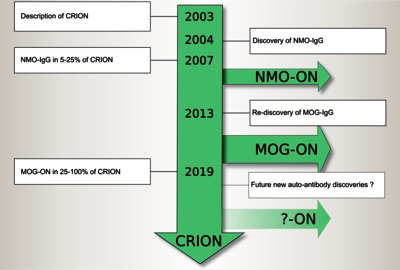Petzold, A;
Woodhall, M;
Khaleeli, Z;
Tobin, WO;
Pittock, SJ;
Weinshenker, BG;
Vincent, A;
... Plant, GT; + view all
(2019)
Aquaporin-4 and myelin oligodendrocyte glycoprotein antibodies in immune-mediated optic neuritis at long-term follow-up.
Journal of Neurology, Neurosurgery and Psychiatry
, 90
(9)
pp. 1021-1026.
10.1136/jnnp-2019-320493.

Preview |
Text (Article)
Petzold_crion-mog-v3-R2-clean.pdf - Accepted Version Download (557kB) | Preview |
![[thumbnail of Figure 1]](https://discovery.ucl.ac.uk/10075304/7.hassmallThumbnailVersion/Petzold_timeline-crion-2019-v2.png)  Preview |
Image (Figure 1)
Petzold_timeline-crion-2019-v2.png Download (984kB) | Preview |
Abstract
OBJECTIVES: To re-evaluate serum samples from our 2007 cohort of patients with single-episode isolated ON (SION), recurrent isolated ON (RION), chronic relapsing inflammatory optic neuropathy (CRION), multiple sclerosis-associated ON (MSON) and neuromyelitis optica (NMO). METHODS: We re-screened 103/114 patients with available serum on live cell-based assays (CBA) for aquaporin-4 (AQP4)-M23-IgG and myelin-oligodendrocyte glycoprotein (MOG)-α1-IgG. Further testing included oligoclonal bands, serum levels of glial fibrillar acidic and neurofilament proteins and S100B. We show the impact of updated serology on these patients. RESULTS: Reanalysis of our original cohort revealed that AQP4-IgG seropositivity increased from 56% to 75% for NMO, 5% to 22% for CRION, 6% to 7% for RION, 0% to 7% for MSON and 5% to 6% for SION. MOG-IgG1 was identified in 25% of RION, 25% of CRION, 10% of SION, 0% of MSON and 0% of NMO. As a result, patients have been reclassified incorporating their autoantibody status. Presenting visual acuity was significantly worse in patients who were AQP4-IgG seropositive (p=0.034), but there was no relationship between antibody seropositivity and either ON relapse rate or visual acuity outcome. CONCLUSIONS: The number of patients with seronegative CRION and RION has decreased due to improved detection of autoantibodies over the past decade. It remains essential that the clinical phenotype guides both antibody testing and clinical management. Careful monitoring of the disease course is key when considering whether to treat with prophylactic immune suppression.
| Type: | Article |
|---|---|
| Title: | Aquaporin-4 and myelin oligodendrocyte glycoprotein antibodies in immune-mediated optic neuritis at long-term follow-up |
| Open access status: | An open access version is available from UCL Discovery |
| DOI: | 10.1136/jnnp-2019-320493 |
| Publisher version: | https://doi.org/10.1136/jnnp-2019-320493 |
| Language: | English |
| Additional information: | This version is the author accepted manuscript. For information on re-use, please refer to the publisher’s terms and conditions. |
| Keywords: | CRION, NMO, aquaporin-4 (AQP4) antibody, myelin oligodendrocyte associated glycoprotein (MOG) antibody, optic neuritis |
| UCL classification: | UCL UCL > Provost and Vice Provost Offices > School of Life and Medical Sciences UCL > Provost and Vice Provost Offices > School of Life and Medical Sciences > Faculty of Brain Sciences UCL > Provost and Vice Provost Offices > School of Life and Medical Sciences > Faculty of Brain Sciences > UCL Queen Square Institute of Neurology |
| URI: | https://discovery.ucl.ac.uk/id/eprint/10075304 |
Archive Staff Only
 |
View Item |


